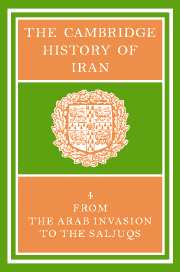Book contents
- Frontmatter
- 1 THE ARAB CONQUEST OF IRAN AND ITS AFTERMATH
- 2 THE ‘ABBĀSID CALIPHATE IN IRAN
- 3 THE ṬĀHIRIDS AND ṢAFFĀRIDS
- 4 The SĀMĀNIDS
- 5 THE EARLY GHAZNAVIDS
- 6 THE MINOR DYNASTIES OF NORTHERN IRAN
- 7 IRAN UNDER THE BŪYIDS
- 8 TRIBES, CITIES AND SOCIAL ORGANIZATION
- 9 THE VISUAL ARTS
- 10 NUMISMATICS
- 11 THE EXACT SCIENCES
- 12 LIFE SCIENCES, ALCHEMY AND MEDICINE
- 13(a) PHILOSOPHY AND COSMOLOGY
- (b) SŪFISM
- 14 THE RELIGIOUS SCIENCES
- 15 SECTS AND HERESIES
- 16 NĀSIR-I KHUSRAU AND IRANIAN ISMĀ‘ĪLĪSM
- 17 ZOROASTRIAN LITERATURE AFTER THE MUSLIM CONQUEST
- 18 ARABIC LITERATURE IN IRAN
- 19 THE RISE OF THE NEW PERSIAN LANGUAGE
- 20 (a) THE “RUBĀ'Ī” IN EARLY PERSIAN LITERATURE
- (b) ‘UMAR KHAYYĀM: ASTRONOMER, MATHEMATICIAN AND POET
- Bibliography
- Index
- Plate section
- Plate section">
- Map 1. Iran under the Abbasids">
- References
11 - THE EXACT SCIENCES
Published online by Cambridge University Press: 28 March 2008
- Frontmatter
- 1 THE ARAB CONQUEST OF IRAN AND ITS AFTERMATH
- 2 THE ‘ABBĀSID CALIPHATE IN IRAN
- 3 THE ṬĀHIRIDS AND ṢAFFĀRIDS
- 4 The SĀMĀNIDS
- 5 THE EARLY GHAZNAVIDS
- 6 THE MINOR DYNASTIES OF NORTHERN IRAN
- 7 IRAN UNDER THE BŪYIDS
- 8 TRIBES, CITIES AND SOCIAL ORGANIZATION
- 9 THE VISUAL ARTS
- 10 NUMISMATICS
- 11 THE EXACT SCIENCES
- 12 LIFE SCIENCES, ALCHEMY AND MEDICINE
- 13(a) PHILOSOPHY AND COSMOLOGY
- (b) SŪFISM
- 14 THE RELIGIOUS SCIENCES
- 15 SECTS AND HERESIES
- 16 NĀSIR-I KHUSRAU AND IRANIAN ISMĀ‘ĪLĪSM
- 17 ZOROASTRIAN LITERATURE AFTER THE MUSLIM CONQUEST
- 18 ARABIC LITERATURE IN IRAN
- 19 THE RISE OF THE NEW PERSIAN LANGUAGE
- 20 (a) THE “RUBĀ'Ī” IN EARLY PERSIAN LITERATURE
- (b) ‘UMAR KHAYYĀM: ASTRONOMER, MATHEMATICIAN AND POET
- Bibliography
- Index
- Plate section
- Plate section">
- Map 1. Iran under the Abbasids">
- References
Summary
INTRODUCTION
The aim of this chapter is to describe scientific activity in Iran during the four centuries beginning about 30/650. In so doing it is convenient to begin with a synoptic introduction, and then to devote a special section to each of the branches of the exact sciences in which significant Iranian work was done. The closing section is a short appreciation of the accomplishments of al-Bīrūnī, a man whose life adorns the period.
As it happens, there is more information about science in Sāsānian Iran than there is about the same subject during the first hundred years of Arab dominance. Although no scientific documents in Middle Persian have survived, it has been established that Greek and Sanskrit works were translated into Pahlavī at the Sasanian court, and some of these documents exist in the languages from which the translations were made. It is also known that the Shāhanshāhs sponsored various versions of the Zīj-ī Shāh (or Zik-i Shahiryār), sets of astronomical tables for the computation of planetary positions, the prediction of eclipses, and such. Further, by piecing together scraps of information from various early Islamic sources, it is possible to obtain a fair idea of the contents and techniques of the various revisions of the Zīj-i Shāh, including the one made during the reign of Yazdgard III, the last Sāsānian monarch.
During the Umayyad dynasty which followed there is not a single name which has come down, either of a scientific book written, or an astronomer carrying out observations. Yet some work must have been going on at this time, as is witnessed by the considerable number of translators available just afterward to put existing technical books into Arabic from Pahlavī.
Keywords
- Type
- Chapter
- Information
- The Cambridge History of Iran , pp. 378 - 395Publisher: Cambridge University PressPrint publication year: 1975
References
- 5
- Cited by

